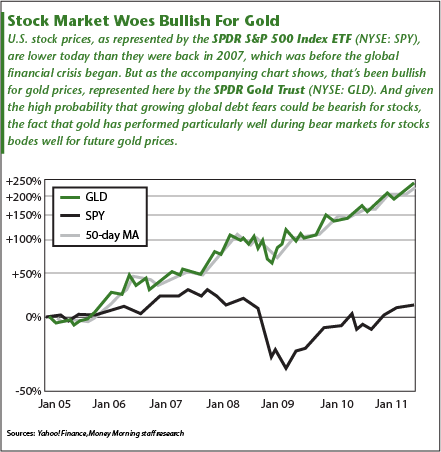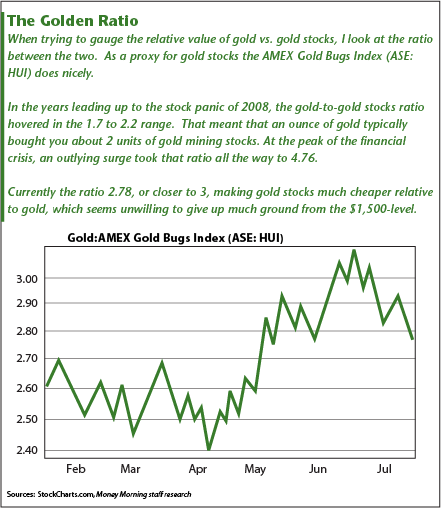For many investors today’s uncertainty and fear is overwhelming: The looming debt debacle in Washington and the potential breakup of the European Union has seemingly crippled their ability to protect their investments and ultimately their future.
Gold and silver are two leading safe havens in times of crisis. However, some investors are taking advantage of the crisis to add a new class of precious and ultra precious metals to their portfolio.
Unrealized Dependence
The rare earth metals, or rare earth elements (REEs) as they are also known, are a collection of 17 elements in the periodic table. Rate earths have gotten a lot of coverage in the last 12-18 months, yet few investors really understand them.
The term ‘rare earths’ comes from the fact that the minerals that contain these unusual elements were quite rare when first discovered in Ytterby, Sweden. However, in reality they’re not all that rare, just hard to refine!
 |
| The 17 rare earth metals have many similar properties, which often cause them to be found together in mineral deposits. |
You likely use rare earth metals every day and don’t even realize it. That’s because rare earths are vital components for modern consumer goods — like rechargeable batteries, DVDs and fluorescent lighting — and also in many environmentally friendly technologies. But prior to the digital revolution and the green movement; most investors had never heard of them.
After all, for many years the rare earths were hardly a vital part of modern industry. The market floundered with low prices and weak demand. It was simply very unattractive to institutional investors, let alone individual traders.
In the 1980s, for example, the rare earths sector was worth less than $100m, and was a money-losing venture.
The idea of a bull market in rare earth metals was continually stalled as cheaper alternatives were used anytime prices rose. Consequently, most countries ignored the forthcoming supply problems.
Except for … China!
China has a long history of being two steps ahead of the rest of the world in the resources markets. And in the case of REEs, they are again! Moreover, in the face of most other nations ignoring the rare earth elements sector, China actually ramped up its efforts to control the industry.
In fact in 1992, Deng Xiaoping compared China’s rare earths to the Middle East’s oil reserves, and he was right.
Rare earths are sometimes referred to as the ‘dragon metals,’ because China has such quantities of them.
Nowadays, the country supplies around 96 percent of global demand for rare earths, a virtual monopoly, especially the heavy rare earths.
But the rare earth market was off the trading radar until last year, when prices really started to take off.
Growing Pains
 |
| China is the world’s biggest supplier of rare earth metals. |
Growth in the rare earth sector has been phenomenal, some say too quick, but I disagree for the most part. The numbers are staggering. The global market for rare earths has grown at an annual rate of about 8-11 percent over the last decade, according to the World Trade Organization. And this pace has spiked in the past 12-24 months or so.
The new middle class is one big driver …
China and the rest of emerging Asia and India are buying electronics goods, such as cameras, iPads, Samsung flat-screens, and many other products as fast as they can! All of those modern doodads simply wouldn’t be possible without rare earth metals.
As these markets have climbed in price, China has been enforcing rare earths quotas, cutting exports by as much as 5-10 percent per year, and pushing prices up rapidly. In 2009 an index holding shares of 12 rare-earth miners rose by more than 600 percent.
Various cryptic statements that have been coming out of China, about its rare-earth quotas, have made markets and end users nervous. The European Commission issued a report back in June 2010, saying it was imperative that a complete supply chain be developed outside of China.
The following month China announced it was cutting exports by another 40 percent. And rumors swirled that China had nearly filled its export quotas by the end of the summer.
Countries such as Japan, which rely heavily on rare-earth imports to produce electronics, have been the hardest hit.
As a result …
Japan Has Taken Action
The Japanese are the most vulnerable in the world to such a sharp drop in supplies of rare earth elements. The impact on their exports could be huge!
So to take back some control over the situation, Japan along with Mongolia has now agreed to explore Mongolian rare-earth reserves together.
Japan is also pulling out all the stops to recycle rare earths from used electronics to help meet some of their needs.
Meanwhile, Japanese car companies, including Honda, Toyota, and Nissan, have long been trying to switch to lithium-ion batteries, which don’t require rare earths, in electric cars. But all of this is more or less futile, as the need for the rare earths is vital to so many of Japan’s top exports.
 |
| The Toyota Prius has been called the biggest user of rare earths of any object in the world. |
The rare earth elements are used for much more than simple electronic gizmos from Japan though …
One of the most common uses is in strategic missile technology and wind turbines. So it’s not a surprise that the U.S. government is getting panicky about the Chinese stranglehold on rare earths and their strategic value.
It won’t be easy to find substitutes for rare earths. The challenge for the industry is whether they’ll be able to supply enough of these elements, and do so as quickly as needed. The answer is probably not.
The fact is that building a new rare-earth supply chain, especially heavy rare earths outside of China, will probably take at least a decade, maybe even much longer than that.
The reasons are simple …
The infrastructure for rare-earths exploration and mining takes years to build — many experts estimate between 5 to 15 years, not to mention billions of dollars.dollars.
So demand is expected to rise while supply tightens, forcing prices to remain high for some time.
Three Ways to Get Your Piece of
the Rare Earth Metals Sector
#1—Individual Stocks
Rare earth producers have had a wild ride the last 18 months and have recently pulled back from their highs. So now may be a very good time to look at adding some of these key companies. You might consider: Lynas Corp (LYC:AX), Molycorp (MCP), and Rare Element Resources (REE).
#2—ETFs
If you’re not comfortable with individual stocks and prefer the diversification of an exchange traded fund (ETF), take a look at the Market Vectors Rare Earth/Strategic Metals ETF (REMX). This ETF from the folks at Van Eck is relatively new so I suggest caution before entering it.
#3—ETF Options
As you have just seen, gold isn’t the only precious metal that glitters … rare earth elements are a vital part of an increasing number of products that a growing world demands every day! And now could be the perfect time to add some to your portfolio.






